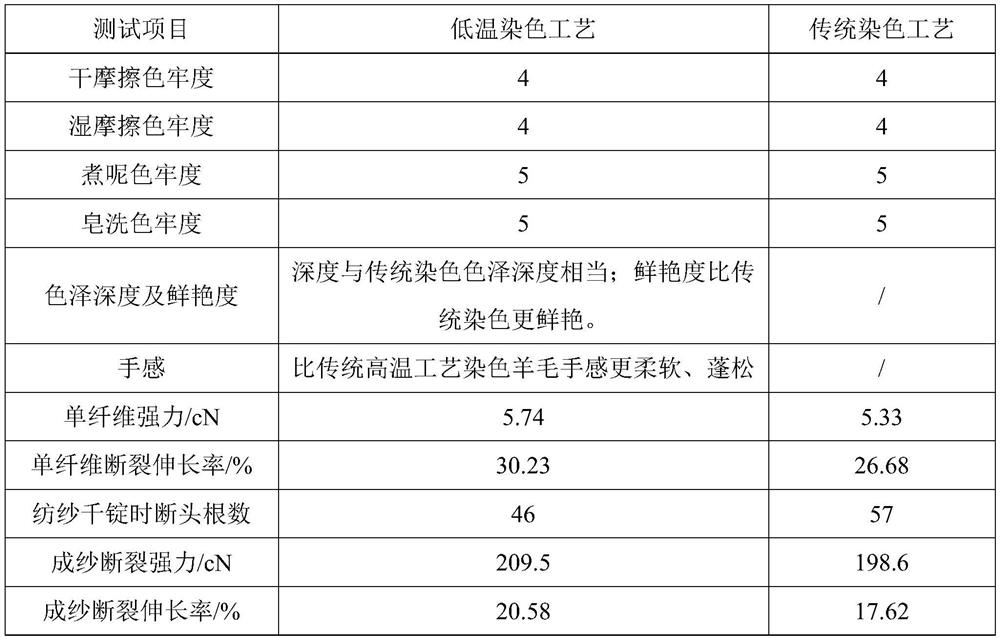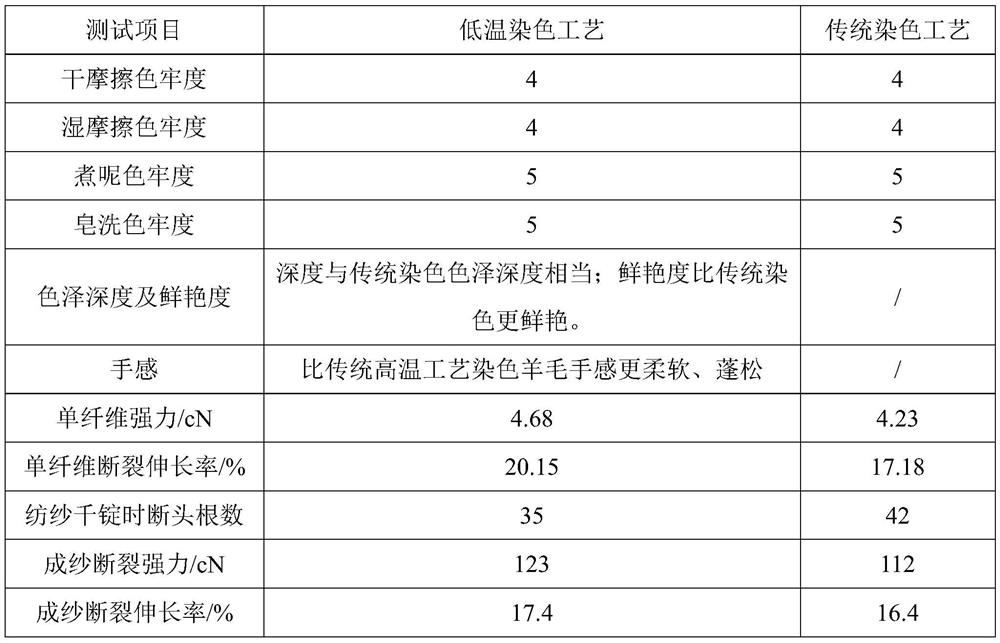Low-temperature dyeing auxiliary agent of wool or cashmere reactive dye as well as preparation method and application of low-temperature dyeing auxiliary agent
A technology of low-temperature dyeing and reactive dyes, applied in the field of dyeing and finishing, which can solve the problems of poor dyeing levelness and color fastness, poor dyeing levelness, high equipment requirements, etc., achieve better color brightness and vividness, improve combing Spinning performance, the effect of lowering the dyeing temperature
- Summary
- Abstract
- Description
- Claims
- Application Information
AI Technical Summary
Problems solved by technology
Method used
Image
Examples
preparation example Construction
[0025] The invention provides a method for preparing a low-temperature dyeing auxiliary of wool or cashmere reactive dyes, the specific steps are as follows:
[0026] Step 1. Prepare cationic Pingpingjia O-10 solution, specifically follow the steps below:
[0027] Step 1.1, by mass percentage, weigh 17.0% of 3-chloro-2-hydroxypropyltrimethylammonium chloride (70% content), 3.0% of sodium hydroxide, 41.0% of Pingpingjia O-10, 0.5-1.0% organic acid, 38.0-38.5% water;
[0028] Step 1.2, mix the water weighed in step 1.1, 3-chloro-2-hydroxypropyltrimethylammonium chloride and sodium hydroxide in a stirring device, react at room temperature for 30-60min, remove hydrochloric acid, and obtain 2, 3-Epoxypropyltrimethylammonium chloride solution.
[0029] Step 1.3, add Pingpingjia O-10 to the 2,3-epoxypropyltrimethylammonium chloride solution obtained in step 1.2, raise the temperature to 80-95°C and keep it warm for 60-120 minutes, and add an appropriate amount of organic Adjust th...
Embodiment 1
[0044] Step 1. Prepare cationic Pingpingjia O-10 solution, specifically follow the steps below:
[0045] Step 1.1, in terms of mass percentage, 17.0% of 3-chloro-2-hydroxypropyltrimethylammonium chloride (70% content), 3.0% of sodium hydroxide and 38% of water are mixed in a stirring device , react at room temperature for 30 minutes, remove hydrochloric acid, and obtain 2,3-epoxypropyltrimethylammonium chloride solution.
[0046] Step 1.2: Add 41.0% Pingpinga O-10 into 2,3-epoxypropyltrimethylammonium chloride solution, raise the temperature to 80°C and keep it warm for 120 minutes, and add 1.0% organic acid to adjust the pH value to 6 ~8, to obtain a 50% cationic Pingpingjia O-10 solution.
[0047] Step 2. Add Pingpinga O-20 to the cationized Pingpinga O-10 solution obtained in step 1 and mix to prepare low-temperature dyeing auxiliaries. Specifically, follow the steps below:
[0048] Step 2.1. Weigh the following materials according to mass percentage: cationic Pingpingjia...
Embodiment 2
[0063] Step 1. Prepare cationic Pingpingjia O-10 solution, specifically follow the steps below:
[0064] Step 1.1, in terms of mass percentage, 17.0% of 3-chloro-2-hydroxypropyltrimethylammonium chloride (70% content), 3.0% of sodium hydroxide and 38% of water are mixed in a stirring device , react at room temperature for 45 minutes, remove hydrochloric acid, and obtain 2,3-epoxypropyltrimethylammonium chloride solution.
[0065] Step 1.2. Add 41% Pingpinga O-10 into the 2,3-epoxypropyltrimethylammonium chloride solution, raise the temperature to 90°C and keep it warm for 90 minutes, and add 1% organic acid to adjust the pH value to 6-8, to obtain a cationized Pingpingjia O-10 solution with a content of 50%.
[0066] Step 2. Add Pingpinga O-20 to the cationized Pingpinga O-10 solution obtained in step 1 and mix to prepare low-temperature dyeing auxiliaries. Specifically, follow the steps below:
[0067] Step 2.1. Weigh the following materials according to mass percentage: ca...
PUM
 Login to View More
Login to View More Abstract
Description
Claims
Application Information
 Login to View More
Login to View More - R&D
- Intellectual Property
- Life Sciences
- Materials
- Tech Scout
- Unparalleled Data Quality
- Higher Quality Content
- 60% Fewer Hallucinations
Browse by: Latest US Patents, China's latest patents, Technical Efficacy Thesaurus, Application Domain, Technology Topic, Popular Technical Reports.
© 2025 PatSnap. All rights reserved.Legal|Privacy policy|Modern Slavery Act Transparency Statement|Sitemap|About US| Contact US: help@patsnap.com


